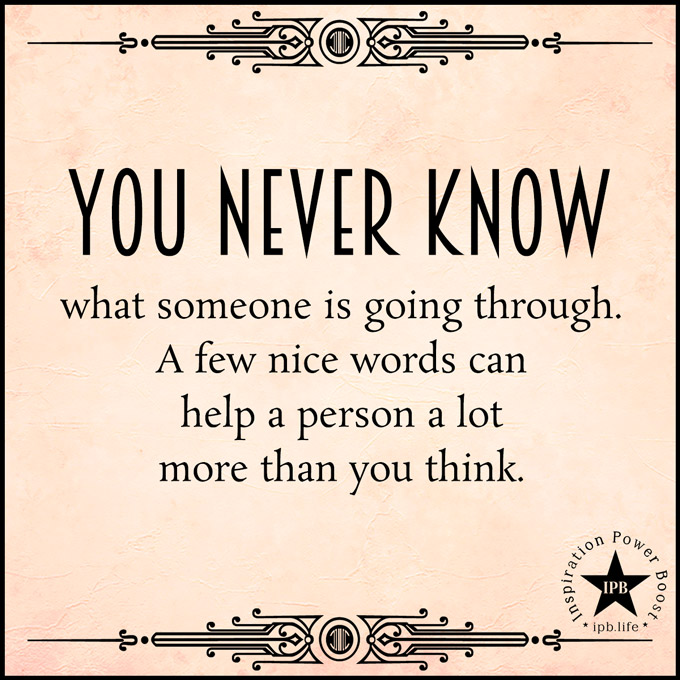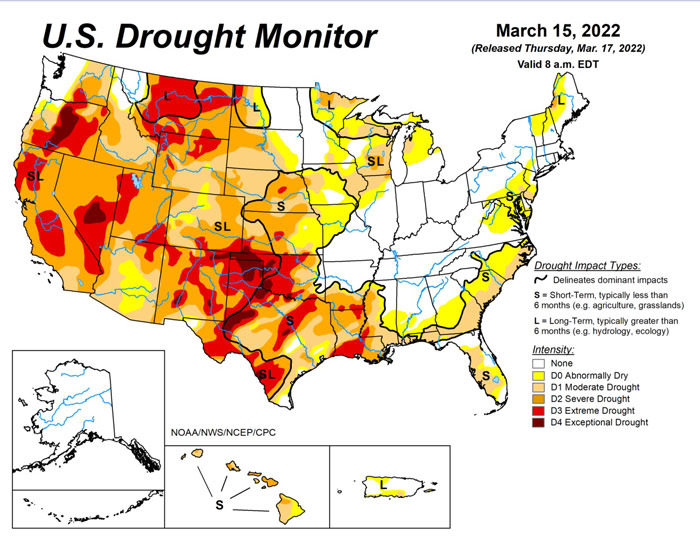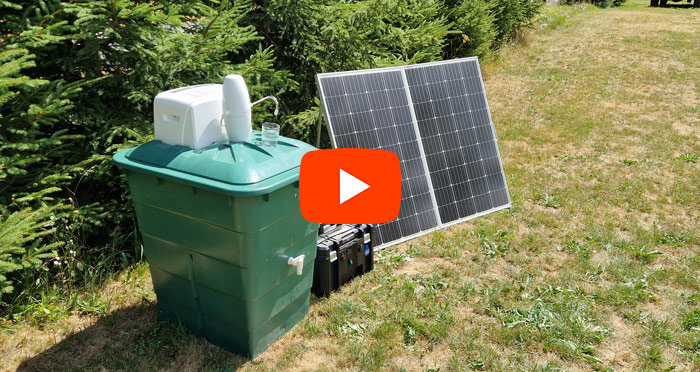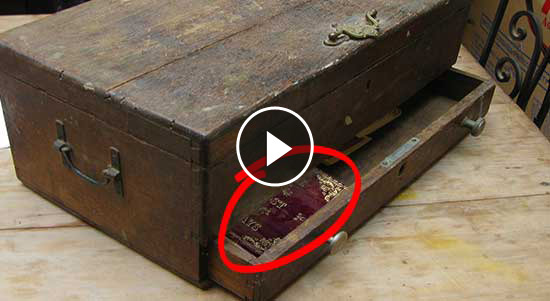
You Never Know What Someone Is Going Through Graphic © Inspiration Power Boost
“You never know what
someone is going through.
A few nice words can
help a person a lot
more than you think.”
Every individual carries their own set of challenges, fears, and insecurities, many of which remain hidden from the world. These internal battles can be as simple as daily stressors or as complex as deep-seated traumas. The truth is, we often have no idea about the struggles someone might be facing behind their composed exterior. This makes it all the more essential to approach others with empathy, understanding, and kindness.
The Immense Impact of Kind Words
Words have power. They can uplift, heal, and inspire. Just a few kind words can act as a balm for someone’s wounded soul or a ray of hope in their moment of darkness. A simple compliment, a word of encouragement, or even a genuine smile can make a world of difference. It’s often the smallest gestures that leave the most profound impact, reminding someone that they are seen, valued, and not alone in their journey.
Creating a Ripple Effect of Positivity
When we choose to spread kindness, we not only uplift the spirits of the recipient but also set in motion a ripple effect of positivity. The person on the receiving end of kind words is more likely to pass on that kindness to someone else. This creates a chain reaction, where one act of kindness leads to another, spreading warmth and positivity in its wake. In a world where negativity often takes center stage, these small acts of kindness can be a beacon of hope and a reminder of the inherent goodness in humanity.
Embracing Empathy in Everyday Interactions
In our fast-paced lives, it’s easy to get caught up in our own world and overlook the feelings and struggles of others. However, by making a conscious effort to be more empathetic and understanding, we can create a more inclusive and compassionate society. It starts with recognizing the power of our words and choosing to use them as tools for positive change. After all, you never truly know the impact your words can have on someone’s day or even their life.
Ways To Practice Empathy
Here is a list of ways to cultivate and express empathy in daily life:
Active Listening: Pay full attention when someone is speaking, without planning your response or interrupting. Show that you are listening through your body language and responses.
Ask Open-Ended Questions: Encourage others to express themselves fully by asking questions that require more than a yes or no answer. This shows genuine interest in their perspective.
Put Yourself in Their Shoes: Try to imagine what the other person is going through. Consider their feelings and experiences from their point of view, rather than your own.
Reflect Back Their Feelings: After listening, reflect back what you’ve heard in terms of their feelings and experiences. This can help validate their emotions and show that you are trying to understand their perspective.
Show Non-Judgmental Attitude: Withhold judgment or advice-giving when listening to someone’s problems or experiences. Being non-judgmental encourages open communication and trust.
Recognize and Respect Differences: Understand that people have different backgrounds, cultures, and experiences that shape their views and feelings. Respecting these differences is key to empathy.
Be Fully Present: Give your undivided attention when interacting with someone. Avoid distractions like checking your phone or thinking about other things.
Use Encouraging Body Language: Nodding, maintaining eye contact, and leaning in slightly are nonverbal ways to show you are engaged and empathetic.
Practice Vulnerability: Share your own feelings and experiences where appropriate. Being open about your vulnerabilities can create a safe space for others to do the same.
Offer Support: Ask how you can help or what kind of support they need. Sometimes, offering assistance or a simple act of kindness can be a powerful display of empathy.
Educate Yourself: Learn about different life experiences, cultures, and viewpoints. Reading books, watching films, or attending events can broaden your understanding of others’ perspectives.
Develop Emotional Intelligence: Work on recognizing and understanding your own emotions, as this can help you better understand and empathize with others.
Practice Mindfulness: Mindfulness exercises can enhance your ability to be present and aware, which is crucial for empathy.
Role-Playing or Simulation Exercises: In certain environments, like training sessions, role-playing can help you experience scenarios from another person’s perspective.
Empathy Mapping: In professional settings, tools like empathy maps can help in understanding clients’ or customers’ needs, experiences, and motivations.
Empathy Maps
An empathy map is a collaborative visualization tool used to articulate what is known about a particular type of person. It is often used in design thinking and user experience (UX) design to help teams develop a deeper insight into their customers or users. The goal is to create a shared understanding of the user’s needs and use these to guide decision-making processes in product or service design.
Structure of an Empathy Map: Traditionally, an empathy map is divided into several sections (usually four), each representing a different aspect of the user’s experience. These sections often include:
Think & Feel: This section captures what the user is thinking and feeling. It tries to understand the user’s emotional state, concerns, aspirations, and changes in their mood.
See: This part represents what the user sees in their environment. It could include the user’s physical environment, the people around them, and things that are influencing their perception.
Hear: This area is dedicated to what the user hears, including direct verbal input from others, ambient sounds, and information sources the user is exposed to like media or advice from friends and family.
Say & Do: This quadrant reflects the user’s actions and verbal responses. It focuses on observable behaviors, how the user might describe their situation and problems, and actions they take.
In the center of the map, the user or persona is typically represented, sometimes with key traits or an image.
How to Use an Empathy Map: To create an empathy map, teams gather and consolidate research data about their users, such as interview transcripts, survey results, or field notes. Participants then fill in each section of the map with insights drawn from this data. The process often involves brainstorming and discussion, helping team members share and develop their understanding of the user.
Benefits of an Empathy Map:
Enhances User Understanding: It compels team members to consider the personal experiences and emotional journeys of their users, leading to a deeper understanding.
Improves Product Design: By centering the design process around the user’s needs and experiences, empathy maps help create more user-focused products and services.
Facilitates Team Collaboration: Empathy mapping is a collaborative exercise that encourages team members to share their insights and perspectives.
Identifies Gaps in Knowledge: The process can highlight what the team doesn’t know about the users, indicating areas where further research is needed.
Daily Affirmation
“Today, I choose to spread kindness and positivity with my words, recognizing the immense power they hold.”
Similar Inspirational Quotes
“Kind words can be short and easy to speak, but their echoes are truly endless.” – Mother Teresa
“Be kind, for everyone you meet is fighting a battle you know nothing about.” – Wendy Mass
“A warm smile is the universal language of kindness.” – William Arthur Ward
“Treat everyone with politeness and kindness, not because they are nice, but because you are.” – Roy T. Bennett
“Kindness is a language which the deaf can hear and the blind can see.” – Mark Twain
😳 What Tinnitus Does To Your Brain Cells (And How To Stop It)
After 47 years of studies and countless brain scans done on more than 2,400 tinnitus patients, scientists at the MIT Institute found that in a shocking 96% of cases, tinnitus was actually shrinking their brain cells.
As it turns out, tinnitus and brain health are strongly linked.
Even more interesting: The reason why top army officials are not deaf after decades of hearing machine guns, bombs going off and helicopter noises…
Is because they are using something called "the wire method", a simple protocol inspired by a classified surgery on deaf people from the 1950s...
This Crazy Off Grid Device Literally Makes Drinkable Water From Fresh Air:
According to NASA, the U.S. is expecting a 100-YEAR LONG MEGADROUGHT.
It's already begun. Ask the farmers in California. They know.
Every survivalist knows that water is of critical importance. You NEED an independent water source that you can count on!
As an interesting "survival rehearsal" - imagine that you turned the tap on right now and nothing came out. How long would you last?
But what if there was another water source literally hidden in plain sight? That's right, I'm talking about the atmosphere!
The amazing thing about getting water from the natural moisture in the air... is that it is ALWAYS available.
This gives you real water security!
Learn more about how to tap into "Nature's secret water reservoir" and stay hydrated when TSHTF!
Watch the video:
Most People Don't Have The Guts To Try This:
An amazing discovery in an abandoned house in Austin, Texas: A lost book of amazing survival knowledge, believed to have been long vanished to history, has been found in a dusty drawer in the house which belonged to a guy named Claude Davis.
Remember... back in those days, there was no electricity... no refrigerators... no law enforcement... and certainly no grocery store or supermarkets... Some of these exceptional skills are hundreds of years of old and they were learned the hard way by the early pioneers.
>> Click here to find out about them now
We've lost to history so much survival knowledge that we've become clueless compared to what our great grandfathers did or built on a daily basis to sustain their families.
Neighbors said that for the last couple of years Claude has tried to unearth and learn the forgotten ways of our great-grandparents and claimed to have found a secret of gargantuan proportions. A secret that he is about to reveal together with 3 old teachings that will change everything you think you know about preparedness:






